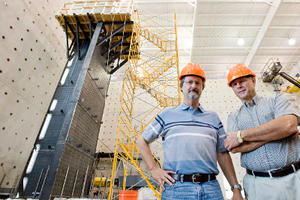InfrastructureSpeeding skyscraper construction -- and making them stronger
Researchers are working on a new technique that could speed construction of skyscrapers while also providing enough stiffness and strength to withstand earthquakes and forces from high winds

The Bowman Core wall, shown above, speeds construction // Source: purdue.edu
Researchers are perfecting a new technique that could speed construction of skyscrapers while also providing enough stiffness and strength to withstand earthquakes and forces from high winds.
The project aims to develop a new kind of “core wall,” a vertical spine that runs through the center of skyscrapers, said Mark Bowman, director of Purdue University’s Robert L. and Terry L. Bowen Laboratory for Large-Scale Civil Engineering Research.
A skyscraper’s core wall supports a portion of the building’s weight and enables the structure to withstand lateral forces from strong winds and earthquakes.
“The intent of our project is to be able to construct the core wall system much faster than the traditional system,” said Bowman, a professor of civil engineering. “If you were doing a 40- to 50-story building, you might save three to four months of construction time. Even one month would be gigantic in terms of dollar savings.”
A Purdue University release reports that Bowman and Michael Kreger, a professor of civil engineering, are leading the research, working with doctoral student Selvarajah Ramesh, undergraduate David Koppes, and engineers from Magnusson Klemencic Associates Inc., an international structural and civil engineering firm based in Seattle.
The research has been funded by the Charles Pankow Foundation, a California-based, private-sector research foundation.
Moving the form progressively upward is a time-consuming operation that cannot proceed until the concrete sets for each floor.
The new system uses a sandwich of steel plates filled with concrete. The hollow structure is expected to be strong enough to stand for several floors, allowing construction to proceed on the rest of the frame before concrete has been poured and speeding construction dramatically, Bowman said.
“The idea has been used in England, but not for high-rise buildings and not in seismic locations,” he said. “We are talking about extending it to high rises and in zones where you get significant lateral forces from earthquakes or high winds. So it’s got to be suitable for Chicago or cities on the West Coast.”
Researchers at the Bowen Lab have built a 3/8th-scale core wall using the construction technique. The specimen is about 30 feet tall.
The release notes that steel rods under tension run from the top to the bottom of the specimen, exerting downward force and simulating the weight of forty stories. Researchers will use powerful hydraulic equipment to simulate the lateral forces exerted by earthquakes and high winds.
“This will tell us how ductile and forgiving the system is,” Bowman said. “It will simulate the deformations and forces seen during an earthquake.”
Data from the research will be used to create design requirements for consultants and building guidelines for contractors.
“Consistent feedback from general contractors confirms that the construction of concrete cores which serve to brace tall buildings is one of the squeaky wheels in the overall construction process,” said Ron Klemencic, president of Magnusson Klemencic Associates. “Anything that can be done to speed the erection of these cores will shorten the overall duration of construction and thus reduce costs. The results of the Purdue testing will provider designers and builders alike with the information necessary to implement this new technology, thus improving the construction of buildings of all sorts.”
The researchers have been working on the project for three years.
“This is a great example of how privately funded university research can translate into benefits for the building construction industry and society, while at the same time providing specialized training for emerging engineers,” said Robert Tener, executive director of the Pankow Foundation and a former civil engineering professor at Purdue.
“Our foundation is pleased that Purdue civil engineering will be delivering this innovative, highly valuable core wall system for industry adoption in 2012.”
